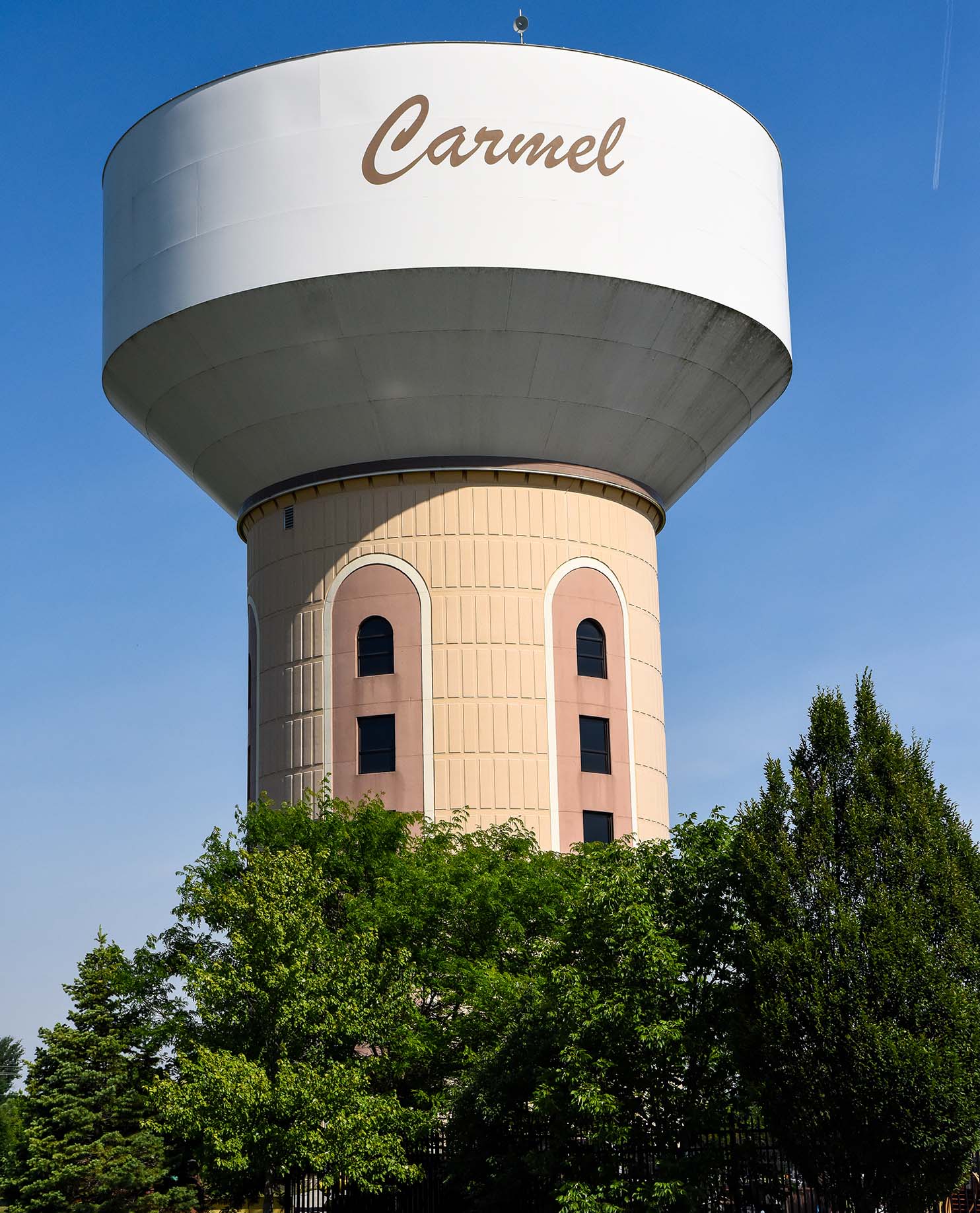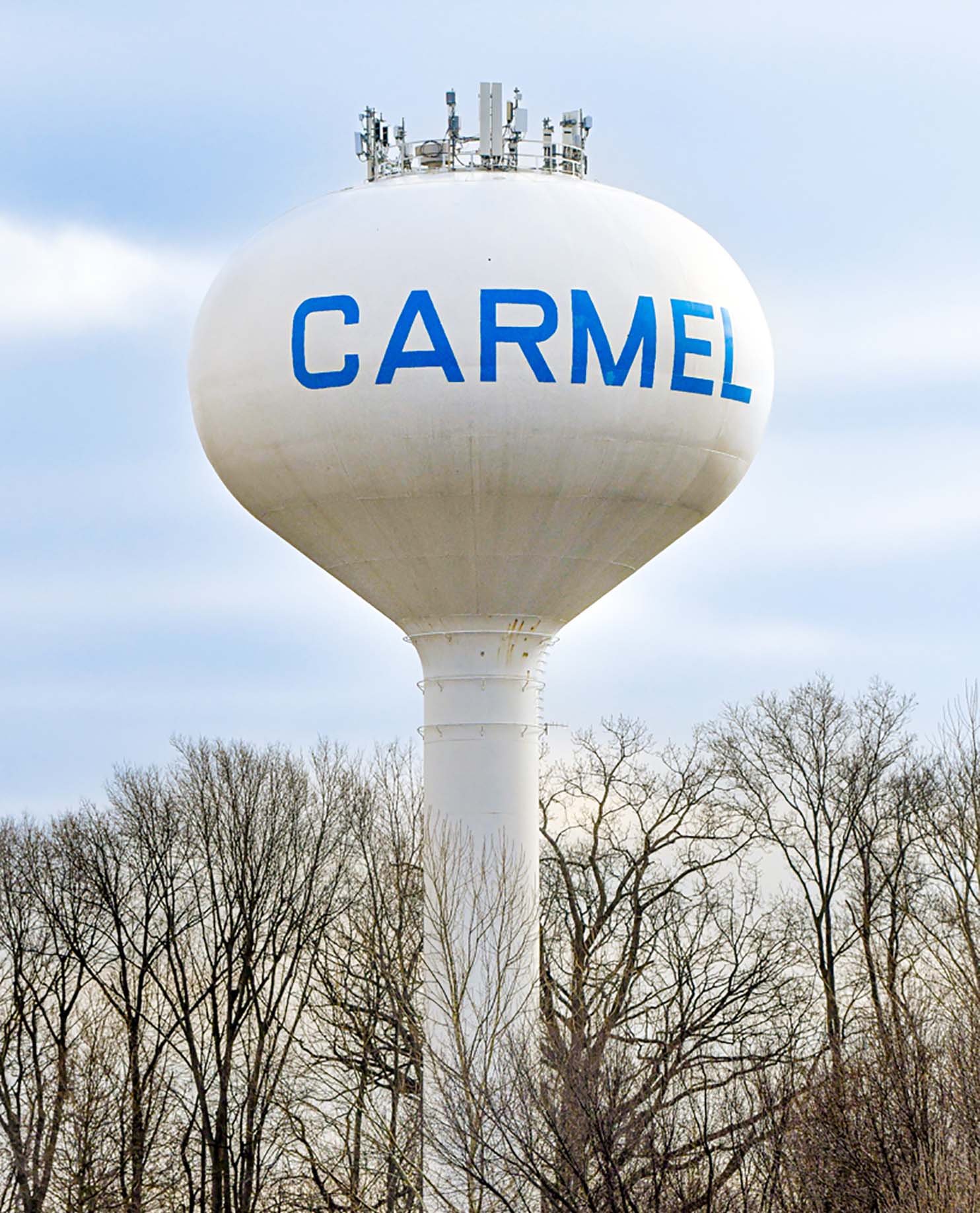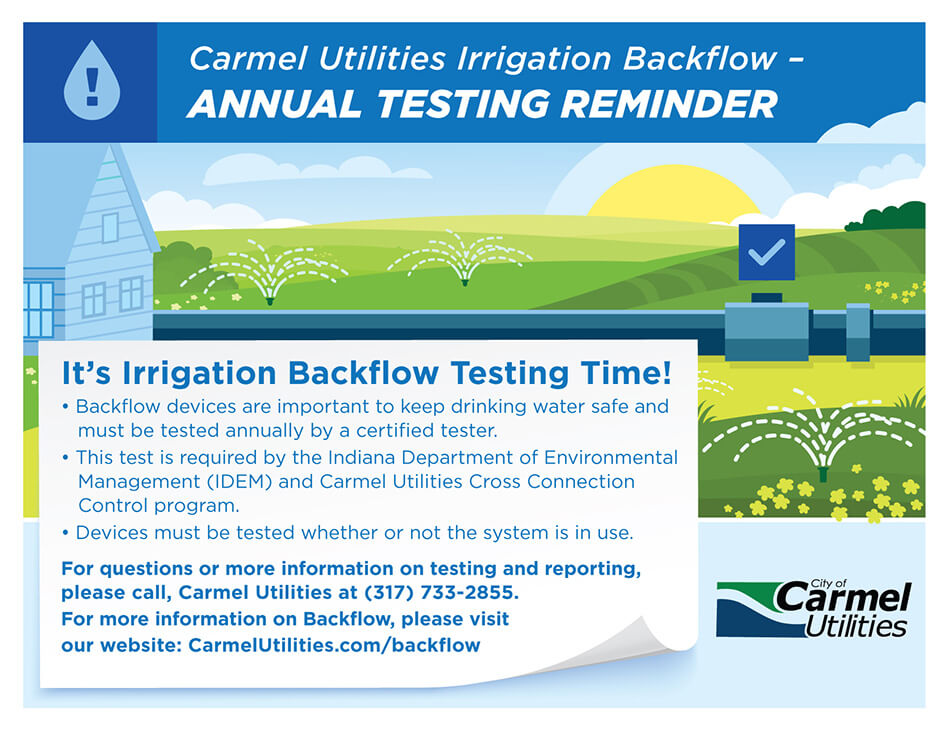Backflow
The purpose of the City of Carmel Utilities Cross-Connection Control Program is to protect the public water supply. The State of Indiana requires that public water systems implement, monitor and enforce a cross-connection control program (Title 327 IAC 8 Rule 10). The City of Carmel, in ordinance A – 69 adopted the following regulations regarding cross connection control within the Carmel Water System.
All backflow and cross-connection control devices must comply with the above-mentioned regulations in regard to installation and testing requirements. Approved devices shall be those listed as approved by the Foundation for Cross-Connection Control and Hydraulic Research of the University of Southern California.
Without proper protection devices, something as useful as your garden hose has the potential to poison your home’s water supply or the public water supply. Over half of the nation’s cross-connections involve unprotected garden hoses.
What is a cross-connection?
A cross-connection is a permanent or temporary piping arrangement, which can allow your drinking water to be contaminated if a backflow or backsiphonage condition occurs.
What is backflow?
It’s just what it sounds like: the water is flowing in the opposite direction from its normal flow. With the direction of flow reversed, due to a change in pressures, backflow can allow contaminants to enter our drinking water system through cross-connections. A potentially hazardous cross-connection occurs every time someone uses a garden hose sprayer to apply insecticides or herbicides to their lawn. Another cross-connection occurs when someone uses his or her garden hose to clear a stoppage in their sewer line.
Without a backflow prevention device between your hose and hose bib (spigot or outside faucet), the contents of the hose and anything it is connected to can backflow into the piping system and contaminate your drinking water.
What harm could that cause?
Plenty. When water is delivered to your property it is exposed to many different types of fixtures, including sprinklers, washing machines, hose-bibs, kitchen faucets, tubs, showers, and toilets. For industrial users, the system may be attached to boilers, photo processing equipment, chemical mixing tanks, chillers, water towers, pressure pumps, healthcare and laboratory equipment, etc. Connections between the potable water system and potential sources of pollution, or contamination, are called “cross connections.” When backflow occurs through a cross connection, there is a chance that contaminants can be drawn into the public water system.
Who can test these devices?
Testers are certified by the State of Indiana after attending a 35-hour training class, passing a written examination, and successfully completing actual tests on prevention devices. When you need to contact a tester, we suggest contacting your backflow irrigation/commercial contractor first. Many of the contractors and/or their employees are certified. Secondly, check the Indiana Department of Environmental Management website (in.gov/IDEM) for Actively Certified Backflow Device Testers in All Indiana Counties. The City of Carmel Utilities can also recommend testing companies and provide a list of active licensed testers in the area. For any questions, please contact Becky Sy with Carmel Utilities (317-733-2870) for more information. Carmel Utilities does not test backflow devices.
What if I have questions?
Questions may be emailed to backflow@carmel.in.gov or call Becky Sy at 317.733.2870
Backflow Replacement Inspection Policy
This inspection is needed to be sure that all requirements and IDEM specifications have been followed. The inspector will be looking that the backflow device has been tested and tagged at the time of installation and that all the new information (serial number & model number) is replaced in our backflow program. This also includes that the new backflow test is submitted to our backflow program within 30 days after installation of the new backflow device.
When does my backflow device need to be tested?
Air Gaps (AG) shall be inspected at intervals not exceeding one (1) year to ensure that they continue to meet the requirements.
Definition: A physical separation between the free flowing discharge end of a potable water supply pipeline and an open or non-pressure receiving vessel. An approved air gap shall be at least double the diameter of the supply pipe measured vertically above the overflow rim of the vessel ? in no case less than one inch.
Reduced Pressure Principle Backflow Prevention Assembly (RP) shall be tested at intervals not exceeding six (6) months (annually, if installed on an irrigation system) to ensure that both check valves are drip tight under all pressure differentials and that the pressure differential relief valve will maintain pressure in the center chamber of at least two pounds per square inch below that of the inlet chamber.
Definition: A device composed of two tightly closing shut-off valves surrounding two independently acting pressure reducing check valves that, in turn, surround an automatic pressure differential relief valve, and four test cocks, one upstream of the five valves and one between each of the four check and shut-off valves. The check valves effectively divide the structure into three chambers, pressure is reduced in each downstream chamber allowing the pressure differential relief valve to vent the chamber to atmosphere should either or both check valves malfunction.
Double Check Valve Backflow Prevention Assembly (DC) shall be tested at intervals not exceeding one (1) year to ensure that both check valves are drip tight under all pressure differentials.
Definition: A device or assembly composed of two tightly closing shut-off valves surrounding two independently acting check valves, with four test cocks, one upstream of the four valves and one between each of the four check and shut-off valves.
Double Check-Detector Backflow Prevention Assembly (DCDA) shall be tested at intervals not exceeding one (1) year to ensure that both check valves are drip tight under all pressure differentials.
Definition: A specifically designed assembly composed of a line-size approved double check valve assembly with a bypass containing a specific water meter and an approved double check valve assembly.
Pressure Vacuum Breakers (PVB) shall be tested at intervals not to exceed six (6) months (annually, if installed on an irrigation system) to ensure that the air inlet opens fully when water pressure is at or below atmospheric pressure.
Definition: A device or assembly containing an independently operating internally loaded check valve and an independently operating loaded air inlet valve located on the downstream side of the check valve for relieving a vacuum or partial vacuum in a pipeline.
New Commercial Construction
Domestic Water Services
Carmel Utilities requires a Backflow Prevention Device be installed on all commercial domestic water service lines. This device must be installed downstream of the water meter and upstream of any branch lines or plumbing. It is highly recommended that a ?Y? strainer be installed before the device.
Automatic Fire Sprinkler System
Carmel Utilities requires that all fire sprinkler systems have a Double Check Valve Assembly installed upstream of the fire riser and Siamese (fire department) connection. If a chemical is used for winterizing or for fire suppression, a Reduced Pressure Principle Backflow Preventer (RP) must be used.
Irrigation Systems
Title 327 IAC 8-10 requires that in-ground lawn irrigation systems have a Pressure Vacuum Breaker (PVB) or Reduced Pressure Principle Backflow Preventer (RP) installed.
Existing Commercial Structures
City of Carmel ordinance A-69, states under what conditions existing facilities (those facilities existing prior to the adoption of the ordinance) must comply with cross-connection control requirements. Briefly, all existing buildings, which house a business activity and are operated as such, will be required to comply with this chapter upon the occurrence of any one of the following events: (a) new ownership of building; (b) remodeling; (c) change of occupancy; (d) installation of a new service line or upgrade of service; (e) addition of machinery or chemicals; (f) designated a cross-connection hazard or (g) if backflow occurs.
Inspection of Cross-Connection Control Devices and Installation of Meters (Commercial Structures)
All backflow device installations must be inspected and tested by a certified tester and a copy of the test report sent to Carmel Utilities prior to starting service for a domestic or fire service line.
Prohibited Connections
No secondary source of water supply shall be physically connected on the customer service line to or into the facility.
Failure to have your device tested in a timely manner could result in loss of water.




